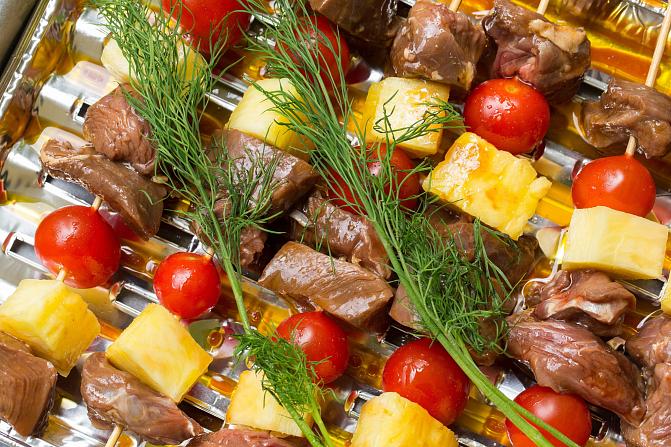What was eaten in Finland in 2021?

Last year, people in Finland consumed an average of 142 kilograms of liquid milk products, 79 kilograms of meat, 84 kilograms of cereals, 15 kilograms of fish, nearly 12 kilograms of eggs, 62 kilograms of fruit and 63 kilograms vegetables each. The previous years’ trends continued: poultry meat consumption increased, and oat consumption remained high. This is indicated by the advance information on the Balance Sheet for Food Commodities published by the Natural Resources Institute Finland (Luke).
According to preliminary calculations, the total consumption of cereals was roughly 84 kilograms per capita in 2021. The total consumption has increased during the last two years, largely driven by the increase in oat and wheat consumption. Last year, the consumption of wheat was 45.4 and that of oats 10.2 kilograms. Rye consumption decreased by roughly five per cent from the previous year, while the consumption of wheat and other bread cereals (buckwheat, quinoa, etc.) increased. The consumption of rye was 14.2, barley 0.9 and rice 6.9 kilograms per capita.
“The peak in oat consumption so far, as much as 11 kilograms per capita, was reached in 2020. In 2021, oat consumption remained high at 10.2 kilograms per capita, marking the second highest figure in the 70-year time series of oat consumption,” says Erja Mikkola, senior specialist at Luke.
Poultry meat consumption only half a kilograms behind pork consumption
The total meat consumption and the consumption of red meat continued to decrease last year, following the previous years’ trend. According to the calculations for the Balance Sheet for Food Commodities, the total consumption of meat was 79.1 kilograms per capita last year, also including game and offal. The total consumption decreased by 0.2 kilograms from the previous year. The meat consumption figures reported in the Balance Sheet for Food Commodities also include bones, i.e. they are calculated as carcass meat. The weight of cooked meat is around 50 per cent of the weight of carcass meat.
The consumption of poultry meat continued to approach the consumption of pork, with the difference only being half a kilograms. Last year, 28.4 kilograms of poultry meat were consumed per capita, roughly 0.9 kilograms more than in 2020. The consumption of pork decreased by approximately 0.8 kilograms from the previous year to 28.9 kilograms per capita. Last year, 18.4 kilograms of beef were eaten on average, down by roughly 0.3 kilograms from the previous year. Lamb consumption was at the previous year’s level at half a kilograms per capita.
Milk consumption was down by two litres from the previous year
The consumption of liquid milk has decreased for several years now, and the trend continued. However, the decrease was only 1.5 per cent last year. The consumption of whole milk decreased by nearly three per cent, and that of skimmed milk and low-fat milk by two per cent combined. All in all, an average of 96 litres of milk was consumed per capita last year, roughly two litres fewer than in the previous year. Some 57 litres of skimmed milk were consumed per capita, accounting for 57 per cent of liquid milk consumption.
According to preliminary calculations, the total consumption of liquid milk products was roughly 142 kilograms per capita. The consumption of sour milk, yoghurt and curdled milk decreased a little from the previous year, whereas that of cream, other soured cream products and other fresh products increased slightly.
The consumption of cheese increased slightly from the previous year to approximately 25.5 kilograms. The consumption of butter decreased a little from the previous year, being 3.1 kilograms per capita.
Egg consumption returned to previous level
Last year, egg consumption was 11.9 kilograms per capita, returning to the level preceding the increase in 2020. People baked and cooked more at home during the first year of the coronavirus pandemic, but not as much in the previous year. Sugar consumption also decreased from 2020.
The consumption of fresh fruit was 56 kilograms per capita. Citrus fruit accounted for 13.8 and other fresh fruit for 42.3 kilograms. Based on foreign trade statistics, bananas accounted for a third of the consumption of fresh fruit. In total, 6.4 kilograms of canned and dried fruit were consumed per capita. The per capita consumption of fresh vegetables was approximately 62.6 kilograms. However, the amount is only indicative and also contains potential waste.
According to preliminary calculations, the total consumption of fish was 14.6 kilograms per capita in 2021. Consumption decreased a little from 2020, when 15.2 kilograms of fish were consumed.
Background to the statistics
The consumption figures of food commodities are based on Luke’s statistics on the Balance Sheet for Food Commodities, containing a summary of the production, domestic use and consumption of the most important categories of food in Finland. The domestic usage of more the 60 products is calculated for the Balance Sheet on the basis of production, changes in stock, exports and imports. Domestic usage is further divided into different purposes: animal feed, use for seeds, industrial raw materials and human consumption. The consumption figures of food commodities are calculated by dividing the human consumption by average population.
The calculation does not indicate the exact amount of food consumption. The figures in the Balance Sheet for Food Commodities represent the amount available for consumption rather than actual consumption, because volumes of storage losses and other waste, among other things, are not available from all stages of the food chain, in which case they are included in the consumption figures.
The total consumption of meat also includes game and offal. The meat consumption figures reported in the Balance Sheet for Food Commodities also include bones, i.e., they are reported as carcass meat. Typically, carcass meat contains 80 per cent of boneless meat. In addition, cooking loss ranges from 10 to 30 per cent, depending on the product. The weight of cooked meat is around 50 per cent of the weight of carcass meat.



